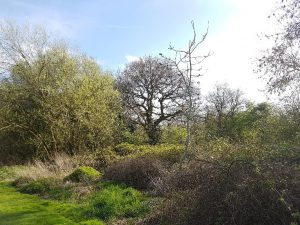Sustainability at the King’s sportsgrounds
Over the last couple of months, the Sustainability Team has been out and about visiting our campuses with an ecologist from the London Wildlife Trust. This forms part of our work on developing a Biodiversity Strategy for King’s, which will launch in the next few months. On our visits, we looked at the current state of biodiversity at our campuses, and at the ways in which we can improve it to make spaces more attractive for students, staff, and of course wildlife. As part of this, we also visited the King’s sportsgrounds. 
King’s has three sportsgrounds across South London: New Malden near Berrylands, Honor Oak Park near Brockley, and The Griffin in Dulwich. While sportsgrounds are not traditionally associated with biodiversity due to the need for pitches to be kept in optimal condition for the many sports clubs using them, the King’s Sport team has successfully made space for wildlife. At Honor Oak Park, biodiversity has even been integrated into the newly built pavilion, which has a green roof.
Particularly New Malden, which is situated next to the Hogsmill River and the Elmbridge Meadows Local Nature Reserve, has seen many biodiversity improvements over the years. The edges of the ground bordering the nature reserve are left untouched, creating a buffer zone between the reserve and the managed sports pitches. The vegetation of various trees and shrubs provides a valuable habitat for birds and small mammals. In addition to this, nesting boxes for various species have been installed across the grounds. Hidden just under the roof of the pavilion are bat boxes, which provide important roosting and resting space for bats struggling to find space in cities. Small bird boxes are scattered across the trees around the edge of the sportsground, and a nesting box and shelf for owls have been installed inside a shed.
While biodiversity features can often be seen as nice ‘extras’, the team at New Malden have recognised that biodiversity can also be an opportunity to directly improve the grounds. For example, instead of replacing netting on a fence, the team has planted a hedge made up of a range of native species. This can provide food for pollinators, space for wildlife once grown, looks attractive to those using the grounds, and is likely to be longer-lasting than netting.
Once our Biodiversity Strategy has been published, we will share it across the university, ask what students and staff would like to see, and work with campus teams to implement it. If you want to read about our plans once we publish our strategy, make sure to follow this blog, our Twitter, or are signed up to our monthly newsletter.

